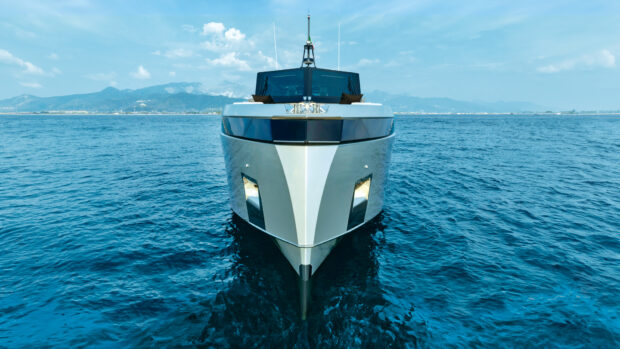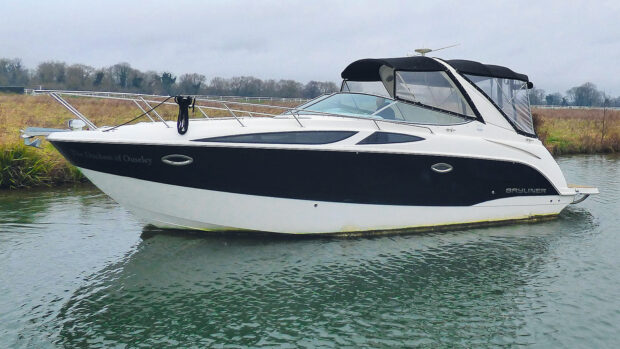The Sunseeker Portofino 40 is a cutting-edge sportscruiser that looks set to become a future classic.
Brand loyalty: it’s why your iPhone will almost certainly be replaced by another iPhone when your contract runs out, the Mercedes dealership will be your first port of call when you come to change your current Mercedes, and why your wife wears a Rolex, same as you.
In sales and marketing, it’s a well-known fact that if you look after your customer and offer him or her a great buying experience and a superior product, then next time around, it’s your door they’ll knock on first.
Trouble is, if you’re a luxury boatbuilder with physically limited build output, you need to balance the increased rewards of larger and more expensive vessels against the greater brand accessibility of cheaper models.
Which is why in the early teenies, with the cold winds of recession buffeting the marketplace, Sunseeker decided that the point of access – at that time the Portofino 47 at north of half a million pounds ex VAT – needed to be reduced in order to encourage more buyers into the brand where they could be gently nurtured up through the range.
Launched at the Southampton Boat Show in September 2012, the Sunseeker Portofino 40 was the answer.

The driver-focussed helm position reflects Sunseeker’s sporty DNA.
But it’s important to understand that this was never intended to be a cheap boat.
It was simply a lower-priced Sunseeker, a point underscored by a base price of £390,000 including VAT – a significant £100,000 north of Princess’s rival 40ft sportscruiser, the V39 launched earlier the same year at the London Boat Show.
That seems a massive disparity, but much of the difference could be explained away via a glance at the options list.
Whilst ostensibly similar – both boats are two-cabin hardtop sportscruisers – Sunseeker offered a wealth of equipment as standard that you’d have been paying extra for from the Plymouth builder.
Great news for the used buyer of course; as a result of this policy, every Sunseeker Portofino 40 on the market comes with an Onan 6kW generator, holding tank, bow thruster, aft cabin double-berth conversion, Simard chartplotter, all-electric galley and various other useful details.
Add-ons
Naturally, this is just the start. It wouldn’t be a Sunseeker without a mouth-watering array of extras to loosen customers’ wallets in a bid to really make their boat their own, and it starts on the outside.
Sunseeker offered a wide variety of hull colours for a small extra consideration, although the vast majority went out with either standard white topsides or glossy jet black – the latter doing a great job of disguising the long run of hull windows.
From a used purchase perspective, the black really does look absolutely fantastic, but it’s worth bearing in mind that white does tend to be that bit more practical, offering a slightly more durable finish and more ably disguising docking indiscretions, as well as being less prone to fading.
Move around to the back of the boat and you’ll find one of three bathing platform options.
A slim platform came as standard, although many customers chose the extended version which trades the potential berthing cost increase of a slightly longer LOA in return for the ability to store a lightweight dinghy fully inflated on the platform.
Need to carry something more substantial? Then look out for one fitted with the second platform option – a high/lo hydraulic affair.
Capable of lifting 300kg, this would, in theory, handle a Williams Turbojet 285, although at 300kg dry weight, it’s on the limit.
You’d get a small jetski on there fairly comfortably though, although do keep in mind that the combined heft of this and the platform hydraulics is a great deal of weight in the worst possible place – right aft.

This beautifully finished interior is one of eight colour combinations offered.
While we’re on the subject of bathing platforms, it’s worth noting that early in the build process, Sunseeker moved the bathing platform ladder from dead centre to the port edge.
This might seem a very insignificant modification – but ask an owner that has the optional centrally transom-mounted passerelle fitted and has climbed the ladder still looking down (as you tend to leaving the sea) and he’ll wince as he explains why this was a good move…
Before we tear ourselves away from the joy of specs, there is one further option worth seeking out.
Sunseeker offered a package option catchily entitled ‘Full Equipment Package – Air Conditioning Specification’.
Designed to simplify the ordering and build process as well as lowering the cost of typically high-spec Sunseeker Portofino 40, it grouped all the most popular options into one bundle that was cheaper than speccing everything separately.
Particularly popular for Mediterranean- based boats, it includes cabin air-con, upgraded navigation equipment with a radar, upgraded interior and exterior hi-fi system, televisions in all cabins, cockpit icemaker and griddle, foredeck sun cushions with folding backrests, and various other useful specification tweaks – everything you could ever ask for and then some.
Outside
Naturally, there is far more to this boat than specifications, and the Sunseeker Portofino 40 cements its Sunseeker credentials with a massive cockpit under the standard-fit open-backed hardtop that features the yard’s first fabric sliding roof for maximum aperture.

The sociable cockpit and wide opening canvas sunroof makes this a great summer party boat.
The aft backrest folds forward to greatly increase the size of the small sunpad aft, or for more sun seeking, head for the foredeck where two sunpad options were offered – a fixed flat version or a more expensive type with folding backrests.
It’s worth noting that one criticism of this area on launch was narrow side decks and a lack of handrails – quickly responded to via canted pulpit rails that reached out almost level with the rubbing band and by extending the high-level rails along the sides of the hardtop – most boats should have these modifications.
Under the cockpit floor, standard-fit twin Volvo Penta D6-330 330hp engines offer a mid-30-knot top end, the alternative D6-400 versions proving a very rare option – few customers willing to pay the £28,000 premium in return for an extra four or five knots – about £7,000 a knot!
Joystick control was another Volvo Penta option, combining steering, throttles and gear shift into single stick and allowing the drives to vector independently of each other.

The contra-rotating propellers are different sizes to optimise torque.
It’s a useful feature but lacks the subtlety and ultimate capability of the IPS pod joystick control from the same manufacturer – tag it as a ‘nice to have’ rather than an essential; there isn’t much you can’t do with twin outdrives and a good bow thruster.
Inside the Sunseeker Portofino 40
Good though the exterior is, it’s the interior of the Sunseeker Portofino 40 that really shines.
Lit by generous overhead skylights and hatches augmented by those huge hull windows that extend across every cabin on both sides, it’s a wonderfully light and airy environment.
As part of the order and build simplification process, Sunseeker developed eight interior combinations of wood, fabric and materials, the idea being that customers would simply pick the scheme that they liked.

Superyacht designer Ken Freivokh helped design the interior look.
Four were by superyacht interior designer Ken Freivokh, and four by Sunseeker’s in-house design team.
Satin-finished cherry and walnut are the more traditional hues – but the avant-garde Freivokh interior of this boat, with its Anigre and Wenge combination of very light and very dark woods, looks superb.
The layout is both standard and conventional, master cabin forward with a central double bed, dinette opposite the galley in the middle and a mid cabin aft.

Multiple hull windows and overheads light up the forward master cabin.
The only notable options were a converting dinette to create a third double (surprisingly not standard given the high specification – check your potential purchase has this if you need to sleep six adults) and an additional small child’s berth on top of the storage lockers in the mid cabin.
Beyond the natural light and abundant space of the interior, the sheer level of detail and finish is what really stands out.
Stainless steel trim, illuminated ‘floating’ cabin steps, leather-wrapped bed frames, concealed high-output air-conditioning vents – this is really a special place to be.
And take a look at the electrics panel with its state-of-the-art colour touchscreen.

This beautifully finished interior is one of eight colour combinations offered.
Despite the Sunseeker Portofino 40’s popularity (75 were built in just over two years), production ended prematurely in 2014.
Even with its premium pricing, the quality of build was so strong that there can’t have been much, if any, profit in each unit.
Whatever the reason, this is still a thoroughly modern, beautifully built craft whose limited production run only enhances its desirability.
Snap one up now before it achieves the status of a future classic in the making.
First published in the September 2016 issue of MBY.
Details
Current value From: £275,000
Length overal: 41ft 0in (12.5m)
Beam: 12ft 8in (3.9m)
Draught: 3ft 6in (1.1m)
Displacement: 11.6 Tonnes
Fuel capacity: 165 gallons (750 litres)
Water capacity: 65 gallons (295 litres)
RCD Category: B
Top Speed: 34 Knots with twin Volvo Penta D6-330 diesels
Cabins: 2
Cruising range: 172 miles at 27 knots with 20% reserve










